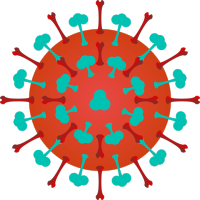| symptom | Restlessness and Stifling |
Restlessness and stifling refers to the symptoms of feeling internal heat and chaotic unease in the heart, due to the location of the disease being in the chest and diaphragm area, hence it is called restlessness and stifling.
Suwen.Liuyuan Zhengji Da Lun states: "The onset of fire stagnation... can lead to dizziness and restlessness and stifling." The "Treatise on Cold Damage Diseases" refers to it as "restlessness and stifling." Zhengzhi Zhunsheng.cold-damage disease includes a dedicated section discussing restlessness and stifling, and later generations have also included this condition under the category of deficient restlessness for discussion.
Restlessness and stifling sometimes co-occurs with epigastric upset, but the two are distinct. The former is mainly characterized by a feeling of depression and discomfort in the heart; the latter refers to a restless disturbance in the stomach area, feeling like hunger but not hunger, like pain but not pain, which is slightly relieved by eating but soon returns to discomfort (discussed in a separate section).
bubble_chart Pattern Analysis
- Heat Disturbing the Chest and Diaphragm︰Restlessness and stifling, vexation and feverishness, stuffiness in the chest, gastric stuffiness, soft upon palpation, or vomiting and regurgitation, or shortage of qi, red tongue with slight yellow coating, deep, rapid and weak pulse. Mostly caused by the transformation of external pathogens into heat after sweating, vomiting, or purging in Taiyang disease, leading to heat disturbing the chest and diaphragm, resulting in "mental restlessness" and the appearance of restlessness and stifling. In addition to the signs of formless pathogenic heat disturbing the chest and diaphragm, there are often manifestations of impeded qi movement, such as stuffiness in the chest, gastric stuffiness, and softness upon palpation. Treatment should focus on dispersing stagnation and clearing heat, with the prescription selection being Gardenia and Fermented Soybean Decoction. For cases with shortage of qi, use Gardenia Liquorice Root and Fermented Soybean Decoction. For cases with prominent vomiting and regurgitation, use Gardenia Fresh Ginger Rhizome and Fermented Soybean Decoction.
- Dampness-heat︰Feeling vexed and restless, with a bright yellow discoloration of the body and eyes like the color of an orange, incomplete sweating, poor appetite, nausea and vomiting, abdominal distension and fullness after eating, scanty dark urine, yellow and greasy tongue coating, and a soggy rapid pulse. This is caused by external pathogens invading the interior, becoming depressed and failing to disperse, obstruction of the middle energizer, dysfunction of spleen in transportation, or irregular diet leading to injury of the spleen and stomach, transforming dampness into heat, and accumulation of dampness-heat that steams upward to the chest and heart. The clinical manifestations of these two conditions are also different. Due to the mutual steaming of dampness and heat, the liver and gallbladder's dredging and discharging functions become impaired, easily leading to jaundice. Other symptoms such as incomplete sweating, scanty dark urine, abdominal distension and fullness, nausea, and vomiting are particularly common signs of unresolved dampness-heat. Treatment should aim to clear and drain damp-heat, using the prescription Virgate Wormwood Decoction.
- Yangming Dryness Accumulation︰Restlessness and stifling, dysphoria (unease), abdominal distension and fullness, abdominal pain (tenderness on pressure), severe constipation, scanty dark urine, red tongue with yellow prickly coating, deep and strong pulse. Treatment should focus on drastic purgation to unblock the bowels, Major Purgative Decoction is the primary prescription.
- Heat Excess Chest Bind︰Hardness and fullness in the heart region, restlessness with vexation, or even hard pain and tenderness from the heart to the lower abdomen, slight tidal fever in the afternoon, thirst, constipation, or stiff neck, or panting, or only head sweating, yellow and thick tongue coating, deep slow and forceful pulse or deep tight pulse. It should be treated by purging heat and expelling water to break bind, Major Chest Bind Decoction is prescribed.
- Deficiency of Both Qi and Yin︰The heart and chest are restless and uneasy, with shortage of qi and profuse sweating, dry throat and choking cough, vomiting and retching with feverish vexation, dry mouth and a preference for drinking, or vacuous vexation and inability to sleep, a red tongue with scant fur, and a rapid, weak, and foreeless pulse. Treatment should tonify qi and nourish yin, with Bamboo Leaf and Gypsum Decoction as the primary remedy.
- Yin Deficiency︰Vexing heat in the chest, palms, and soles, night sweats, insomnia, flushed cheeks, dizziness, tinnitus, dry mouth and throat, soreness in the waist and weakness in the legs, a red tongue without coating, and a thready and rapid pulse. The treatment should focus on nourishing yin and reducing fire, with Anemarrhena, Phellodendron, and Rehmannia Decoction (Zhi Bai Dihuang Tang) as the main prescription. Alternatively, other formulas such as Sour Jujube Decoction or Major Yin-Tonifying Pill may be selected based on the specific symptoms.
- Yixue Gangmu.On vexing heat: "Severe palpitation due to vexing heat indicates that the heat is in the heart and lungs, hence Bamboo Leaf Gypsum cinnabar is used to subdue the heat and bring it down. Vexing heat with diarrhea indicates that the heat is in the upper body, hence Gardenia and Fermented Soybean Decoction is used to induce vomiting. Vexing heat with perspiration that does not resolve indicates that there are pathogens both in the exterior and interior, hence the Exterior-Interior Decoction is used. A deep pulse with thirst and heat in the palms indicates that the heat is not in the exterior, hence the Miraculous Fragrance Pill is used for purgation. Warm the Gallbladder and Sour Jujube are used to treat insomnia."






